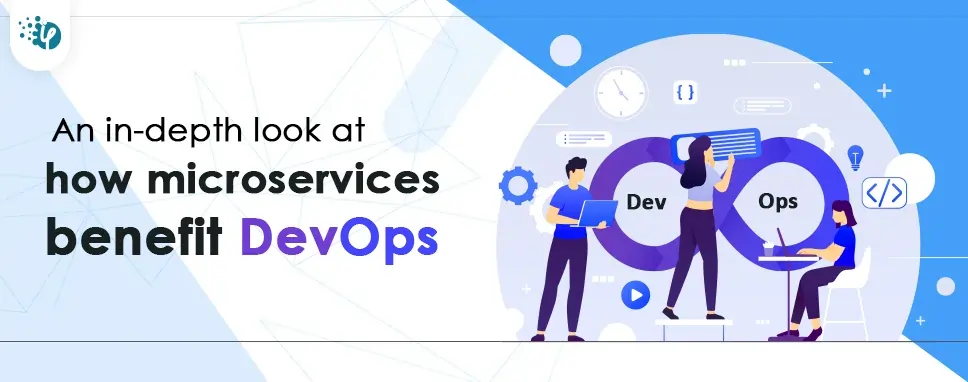How to Do Forecasting in Power BI (Steps & Accuracy Metrics)
Remember our last guide - Power BI forecasting? It revealed things that truly blocks accuracy, both structural and situational. Now it's time to take the next step. Knowing Power...
Listening is fun too.
Straighten your back and cherish with coffee - PLAY !

Microservices have created quite a stir in the software industry and have been adopted steadily in recent years. Organizations are drawn to it because it seeks to speed up the software development process through continuous integration and continuous deployment (CI/CD). Many giants such as Amazon, Google, Uber, Netflix, etc. are utilizing it for the purpose of delivering products much faster with improved quality.
Microservices enable developers to write independent pieces of code and execute them parallelly. In addition, it also eliminates the burden of managing programs cross-functionally. In this blog, we will look in detail at how Microservices can benefit DevOps.
Microservice architecture benefits DevOps by providing it with greater modularity than DevOps can achieve on its own. This modularity enables several DevOps teams to create and deploy these independent building blocks concurrently. Moreover, developers do not have to spend long stretches of time writing unique code for each platform because microservices are easily deployed in any cloud platform. In summary, microservices provide the DevOps teams with greater flexibility for deployment, as well as more opportunities for development, while being cost and time efficient.
- Eric McGee, Senior Network Engineer at TRGDatacentersMicroservices boost DevOps productivity by embracing a unified toolkit that can be used for both development and operations. This common toolkit establishes a common vocabulary as well as processes for needs, dependencies, and difficulties. As a result, it's easier for Devs and Ops to collaborate, allowing them to work together on a problem and effectively change a build configuration or build script. When DevOps and microservices are used together, they are more effective.
- Nicholas Rosenfeld, Director at Making a WillDevOps is concerned with the continuous monitoring, testing, and deployment of software. Because they are designed to perform a single function, microservices are inherently modular. Modular software fits easily into the DevOps structure, allowing for easy incremental changes. A single microservice should be simple to upgrade, build, test, deploy, and monitor. Microservices provide some advantages to DevOps fields, such as deplorability increased agility leads to shorter build, test, and deploy cycles, reliability, availability shorter time to deliver a new version, scalability, and modifiability (more flexibility to consume new frameworks, data sources).
- Andrew White Owner Of TechgearoidDevOps is all about monitoring, testing, and deployment of different software, whereas Microservices are designed to perform singular functions. Both, when paired together, can speed up the delivery time and quality simultaneously since microservices typically act as a catalyst for DevOps. Since both shares similar organizational and developmental cultures, such flexibility of speed and scalability brings agility to the services, which is again another major benefit of using microservices for DevOps. Next, Microservices also bring benefits in deployability, resulting in quicker and shorter spans of testing and cycles and better reliability and availability in the market. It eases the entire process and brings flexibility in consuming new frameworks, data sources, and other resources, resulting in more productive and result-driven outcomes.
- Christian Velitchkov Co-Founder of Twiz LLCMicroservices allow DevOps teams to work on separate parts of functionality at the same time. Rather than shifting code from one type of specialist to the next (e.g., development, testing, and production), cross-functional teams work together to build, test, release, monitor, and maintain programs. Microservices' independence allows DevOps teams to accomplish more in less time. Unlike monolithic software, where a bug might cause the entire application to crash, a microservice bug usually affects only that microservice. A microservice failure, on the other hand, can put other microservices under stress, which could result in other microservices being unable to communicate with the failed microservice.
- Katherine Brown Marketing Director of SpyicMicroservices architecture is an excellent way to break down complex applications into smaller pieces that can be developed, tested, and deployed quickly. This allows DevOps teams more time developing their application while providing them with increased flexibility when designing it from scratch or modifying the existing codebase for future changes without disrupting the business continuity overall.
- Amit Raj, Founder of The Links GuyDevOps is benefiting our customers most were responding with new features, functions, or content, they have the opportunity to aid or influence a customer. There have been a large number of examples over the last 90 days as companies have had to deploy more functions online, increase communication with employees, suppliers and customers, in order to navigate the pandemic and the societal restrictions around the globe. DevOps and organizational agility go hand in hand. There are some notable examples where DevOps technology processes have been in place, but organizations were slow to make decisions. In these cases, DevOps could still deliver changed code quickly, but the benefit was muted. Other organizations that did make quick decisions, had to implement change in their systems in an un-coordinated and often delayed manner. For example, some retailers were updating web and mobile content relatively rapidly, but not being able to change features, or functions. They could direct people to phone in an order for pick-up, or send in an e-mail with their order, but took a very long time to (and a few are still struggling) to integrate online/mobile capability with the local store. Others were able to accelerate their efforts for omni-channel and you could see the increased functionality weekly. We saw similar issues with companies supporting work from home. It was interesting to see what applications were not well enabled for remote access in several companies. The ability to respond rapidly to improve functionality for remote access was a definite advantage for some companies. Employees could have obstacles to productivity under the new operating models addressed much faster where DevOps was already in place.
Companies that have accelerated their DevOps adoption due to the pandemic, run into many of the same issues as they adopt or scale. Quality engineering integrated into the DevOps process has been the most common issue I have seen. Many organizations that had started DevOps, did not have an integrated and automated quality process engineered in, or if so, it was rather product or stack dependent and had to address issues in order to scale. The other issue was in rapid deployment of infrastructure. Not all apps were cloud enabled, or their deployment significantly increased the need, or scope or operational or security monitoring. Having integrated monitoring and management tools that look across the entire infrastructure with a process, or application focus made this much easier. Organizations that had this in place had very few operational deployment issues when asked to scale new functionality rapidly. It became about financial management rather than technical feasibility. (ex. Do we have the budget to triple number of users...). Similarly, a well-equipped SOC, that already had good automation, was able to accommodate the increase in users and touchpoints faster and with less risk.
- Robert Dutile, Chief Commercial Officer, UST.comOnce everything is broken down into separate services, divide your development team and assign them a specific service. It reduces the scope of development, making them more flexible. Each service can be written in a different language or technology reducing incompatibility and allowing DevOp’s teams to use the most suitable tech stack for each module. The services can be deployed in multiple servers reducing the performance impact of more demanding components.
- Harriet Chan, marketing director at Coco Finder.The DevOps strategy is suitable for Microservices-based systems since it facilitates development, allows for seamless upgrades, and controls each service without the risk of the entire application failing. It improved reliability by guaranteeing that problems with one service do not affect the rest of the application. End-to-end automation of the testing and delivery processes is possible thanks to the combination of DevOps and microservices. As a result, timely detection, and resolution of faults in a specific service is made possible while the remainder of the application remains active.
- Marilyn Gaskell Founder & Hiring Manager of True People SearchMicroservices fetch some extraordinary benefits to DevOps fields, for example, deployability. It has maximized agility that leads to short test, build, and deploy cycles. Both of them share organizational development and structure cultures likewise. They have a common interest in cloud-oriented automation and infrastructure and an identical desire for speed, development, and scalability. All of these can be well fitted to agile development. In brief, the adoption of such methods led to the emergence of concepts supported by CD and CI microservices.
- Stephen Curry CEO of CocoSignThe importance of Microservices and DevOps has grown for organizations. These techniques are intended to improve enterprise agility and efficiency. Thus, DevOps is critical to microservice success. The goal of DevOps is continuous software development. Microservices are naturally modular due to their sole purpose. Modular software is easily integrated into DevOps structures, allowing for easy incremental adjustments. Unified management of a single microservice should be simple. Similarly, DevOps fits wonderfully. With a microservices-based architecture, DevOps improves both delivery time and quality. The advantages of dependability, availability, and management Scalability, modifiability, and management are just a few of the benefits of using microservices in the DevOps world. Microservices increase DevOps productivity by enabling a single toolkit for both development and operations. This toolbox can standardize needs, dependencies, and difficulties. All of this helps DevOps operate and troubleshoot. Together, DevOps and Microservices work better.
- Daniela Sawyer, Founder of FindPeopleFast.netFor one, a microservice architecture enables concurrent developer workflows, meaning that development can be organized around independent pieces of functionality that can be developed in parallel. .
This, in turn, has implications around testing and deployment where DevOps can focus only on those components that are changed or updated, rather than the entire system.
The use of microservices also introduces some critical improvements to the SDLC (software development life cycle) that improves DevOps performance by reducing risk. These take the form of improved performance around service reliability: a system fault within a microservice usually only affects that particular service rather than the entire system.
-Sage Young work for FueledDevOps is a term that has come to be used as an umbrella term that loosely groups together technologies and practices around automation and infrastructure. Microservices offer DevOps teams and organizations a standardized and scalable way to develop and deliver their services. They provide developers with the ability to craft smaller, independent modules or components that can be easily replaced or updated by other developers without affecting the greater system.
Microservices work well with DevOps teams because they allow for the automation of many tasks. They allow the teams to operate at a higher scale, which allows them to create services that can be deployed quickly and efficiently. Additionally, the modularity of microservices provides teams with an opportunity to release new versions of their products more frequently without significant risk.
-Lynda Co-founder of NumlookerAs the name suggests, microservices break down large, complex beasts into smaller, more manageable pieces. With this, different DevOps teams can be responsible for and successfully manage these bite-sized bits in tandem. Needless to say, there are many benefits to reducing a team’s scope, but the largest is increased productivity and accelerated innovation. Rather than continuously moving projects across specialties, microservices allow cross-functional DevOps teams to cooperatively complete projects in modules.
Alternatively, there’s a contrasting point of view: microservices can actually increase a project’s complexity. Because there are more moving parts to wrangle, there are risks of duplication and differing standards across different teams. However, overall, the benefits of microservices significantly outweigh the potential drawbacks, enabling incremental releases for faster delivery and improved quality to end-users.
-Rob Newsome HOM at stack.ioThe biggest advantage to microservices is that a single failure will not take down your entire application. Consider what happened to Facebook a few days ago. While they used Microservices, all of their services were resolved via a single DNS. When that failed, their entire network of applications failed.
In a monolithic application, all the pieces are tied together. If one fails, it could bring down the entire application. With microservices, a single failing service will only take down a single part of the application. This means that failure impacts are isolated and minimized. This aspect of microservices also makes it far easier to debug when there are issues. We can see the impacted part of the application and can focus on the subset of microservices that support that particular part.
-PhilStrazzulla CEO of Select Software ReviewsUltimately, the benefit rests in the fact that microservices serve to let your teams work on different platforms or business units without relying on the same applications or issues. Using traditional methods, if one issue comes up during the project, it can be stated that either they are all going through the same blocks as everyone else. By integrating microservices, your DevOps teams can work around them and continue through other applications without stopping the project in its entirety. Although the main con of using microservices is that sometimes communications might be stifled due to using different services, the pro of managing around systems issues or help tickets can help save time and money in the long run.
-Carla Diaz Cofounder of Broadband Search"The goal of DevOps is continuous software development. Microservices are inherently modular due to their single purpose. Modular software is easily integrated into DevOps structures, allowing for easy incremental changes. Unified management of a single microservice should be simple. Similarly, DevOps fits perfectly. With a microservices-based architecture, DevOps improves both delivery time and quality.
So continuous delivery pipelines can maintain a steady flow of deployments. A similar feature of containerized microservices is that can be deployed quickly and easily across multiple systems.
Automated operation improves the microservice approach by making it more adaptable and scalable. Using DevOps and Microservices in development and testing improves team output and service quality.
They also share organizational structures, development cultures, and an interest in cloud-based infrastructure and automation. They both want development, speed, and scalability, all of which fit into agile development.
With the adoption of agile methods came the concepts of Continuous Integration (CI) and Continuous Delivery (CD). Using a quality-focused philosophy, CD speeds up the deployment pipeline.
Microservices-based architectures necessitate change, which is often welcomed by developers of modern applications. These changes allow for rapid productivity gains and faster delivery of solutions to users who need flexible, scalable applications.
Reliability, availability, and management are some of the benefits Microservices bring to DevOps fields, such as increased agility, shorter build, test, and deploy cycles, scalability, modifiability, and management."
- Jan Chapman Managing director ofMSP Blueshift"Microservices carefully engineer continuous delivery and deployment that fasten up the process of software delivery. DevOps practices of cloud-native organizations that customarily delivered software with buffed finesse and speed gave birth to microservices. DevOps emphasizes persistent software monitoring, testing, and deployment. Because microservices are designed to fulfill a particular task, they are naturally modular. Modular software integrates readily into the DevOps framework, allowing for easy incremental modifications.
Furthermore, DevOps techniques include the concept of breaking huge problems down into smaller bits and solving them one at a time as a team. Microservices are important in DevOps because they utilize small teams to make functional adjustments to an organization's services. Microservices are all about making it easier for small teams to install and collaborate in a relaxed atmosphere.
Microservices shepherded rapid deployment of newer versions of service with the help of its agility and overall polished edges. Shorter build, test, and deploy cycles were credited for this agility. Microservices also offered the space and freedom to utilize service-specific security, replication, persistence, and monitoring options.
Microservices have an individualist sphere of consequences of a crash. In case of a fault, it solely impacts that microservice and its users. It is very unlike monolithic applications that stopped the entire monolith from functioning in cases of faults."
Introducing a new version of a microservice is easier and demands a relatively lesser amount of downtime, whereas introducing a the new version of a service in a monolithic application typically necessitates a complete restart of the monolith."
Pools, clusters, and grids can be used to scale microservices separately. Microservices are an ideal fit for the cloud's elasticity because of this deployment capability."
It is fairly easy to use newer frameworks, libraries, data sources, and other resources with microservices. They can be handled in an uncomplicated manner due to their modular components being loosely spun with each other, allowing dynamic discovery and binding via a registry."
Microservices have the scope of benefitting from the agile approach, which divides the application development effort among smaller, more autonomous teams.
Microservices accommodate a common unified toolkit that can jockey development and operations to hike productivity levels in DevOps. This common toolkit works within a bailiwick that has special defined terminology as well as procedures for requirements, dependencies, and issues. As a result, it becomes simpler for Devs and Ops to collaborate, allowing them to work together on an issue and effectively repair a build configuration or build script. When DevOps and microservices are used together, they are more effective."
- Marcus Valdez, founder of The Game Dial"DevOps is the IT industry's way of dealing with the pain of loss of business revenue due to slow time to market. In other words, businesses that depend on software lose a lot of revenue due to not innovating fast enough. When businesses are not innovating fast enough the issues can be traced to the efficiency of their software development process.
Traditionally, businesses come up with an idea, and their software development team (Dev in DevOps) does some analysis & design, build out the feature, tests it and then hands it over to their software operations team (Ops in DevOps) to deploy it and have it ready for use (production)"
So, software development teams traditionally build software as one big lump which they hand over to the operations team that deploys it into production and in turn becomes responsible for issues.
DevOps is a set of philosophies and practices that aim to blur the line between software development and operations by advocating for Continuous Integration (CI) and Continuous Delivery (CD). Continuous integration and continuous delivery are popularly referred to as CI/CD. CI/CD promotes and encourages smaller and more frequent updates to software supported by automation. This way, issues are easier to identify and deal with. To deal with the issue of a whole system crashing because of newly introduced features, one can turn to microservices in order to avoid building monolithic systems.
Microservices is a pattern of building and running software that requires splitting large (monolithic) systems into smaller systems that work together (microservices). How this helps with DevOps is that it forces each microservice to act independently and not expect the other microservices it depends on to always be available. This prevents a failure in one microservice from bringing down the whole system and making it unavailable, instead only the failed microservices become unavailable.
DevOps benefits from microservices in that teams that are responsible for building these microservices can easily take ownership and also operate them. Having a smaller codebase to manage (when compared to its monolithic version) means a lot more of the development and operations activities can be automated. This removes the extra layer of communication needed between development and operations teams. Also, when developers know they are responsible for any issues, they do all they can to make sure things run smoothly in order to avoid those 02:00 AM calls.
Microservices force development teams to organize around function rather than technology. This means that teams operating in a microservices setting will tend to have all the technology experts within the team and their focus is to deliver value around the function they are responsible for."
- Bulama Yusuf CEO ofIntellectual AppsMicroservices benefit DevOps with increased agility and quality-focused ideology. It enables faster updates to production via CI/CD (continuous integration / continuous delivery) and accelerates the industry's product development process. This article has gone into detail about how microservices assist DevOps. It will help you understand how Microservices can be used to simplify workflows.

Remember our last guide - Power BI forecasting? It revealed things that truly blocks accuracy, both structural and situational. Now it's time to take the next step. Knowing Power...

Did you know that 70% of CTOs (Chief Technology Officers) hesitate to adopt Microsoft Power BI because of its myths and misconceptions that float around. What they fail to see is...

Every CTO knows the struggle of managing complex reports. The inefficiency of scattered data, the constant juggling between reporting tools, the challenge of ensuring accurate KPIs...